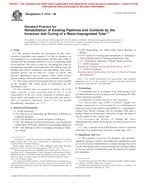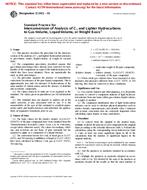1.1 This test method covers the determination of the density of soil in place by the sleeve method.
1.2 The sleeve method of determining the density of soil in place is used for cohesionless, granular soils for which other methods of determining the density (sand cone, test pit, and the like) may not be practical. Typically, the sleeve method is applicable for soils that are predominantly fine gravel size, with a maximum of 5% fines, and a maximum particle size of 3/4 in. (19.0 mm).
Note 1-There have been other methods developed for testing cohesionless soils. Compared to other methods, this procedure is convenient for field construction control testing because smaller and lighter equipment is used and the test can be performed in a smaller area.
1.3 A calibration equation is necessary in the application of this test method to obtain a reliable value of the in-place density of the soil (see Annex A1). The calibration equation is used to calculate the density of the soil in place from the mass of dry soil per inch of test hole measured by the sleeve method.
1.3.1 The calibration equation is predetermined for a particular soil type that is to be tested. When the soil changes significantly in either gradation or particle angularity, the calibration equation may have to be adjusted or redefined before the sleeve method can be used.
1.3.2 There may be certain soils meeting the general description in 1.2 for which a calibration equation may not be appropriate due to unsatisfactory correlation of the data. The sleeve method would not be applicable for these soils.
1.3.3 There may be certain soils meeting the description in 1.2 for which the calibration equation may be applicable only for a certain range of densities. The sleeve method will give reliable values of the density in place only within that range of densities.
1.4 It is common practice in the engineering profession to concurrently use pounds to represent both a unit of mass (lbm) and a unit of force (lbf). This implicitly combines two separate systems of units; that is, the absolute system and the gravitational system. It is scientifically undesirable to combine the use of two separate sets of inch-pound units within a single standard. This standard has been written using the gravitational system of units when dealing with the inch-pound system. In this system the pound (lbf) represents a unit of force (weight). However, the use of balances or scales recording pounds of mass (lbm), or the recording of density in lbm/ft should not be regarded as nonconformance with this test method.
1.5 This standard does not purport to address all of the safety problems, if any, associated with its use. It is the responsibility of the user of this standard to establish appropriate safety and health practices and determine the applicability of regulatory limitations prior to use.
Product Details
- Published:
- 01/01/1993
- Number of Pages:
- 8
- File Size:
- 1 file , 96 KB


